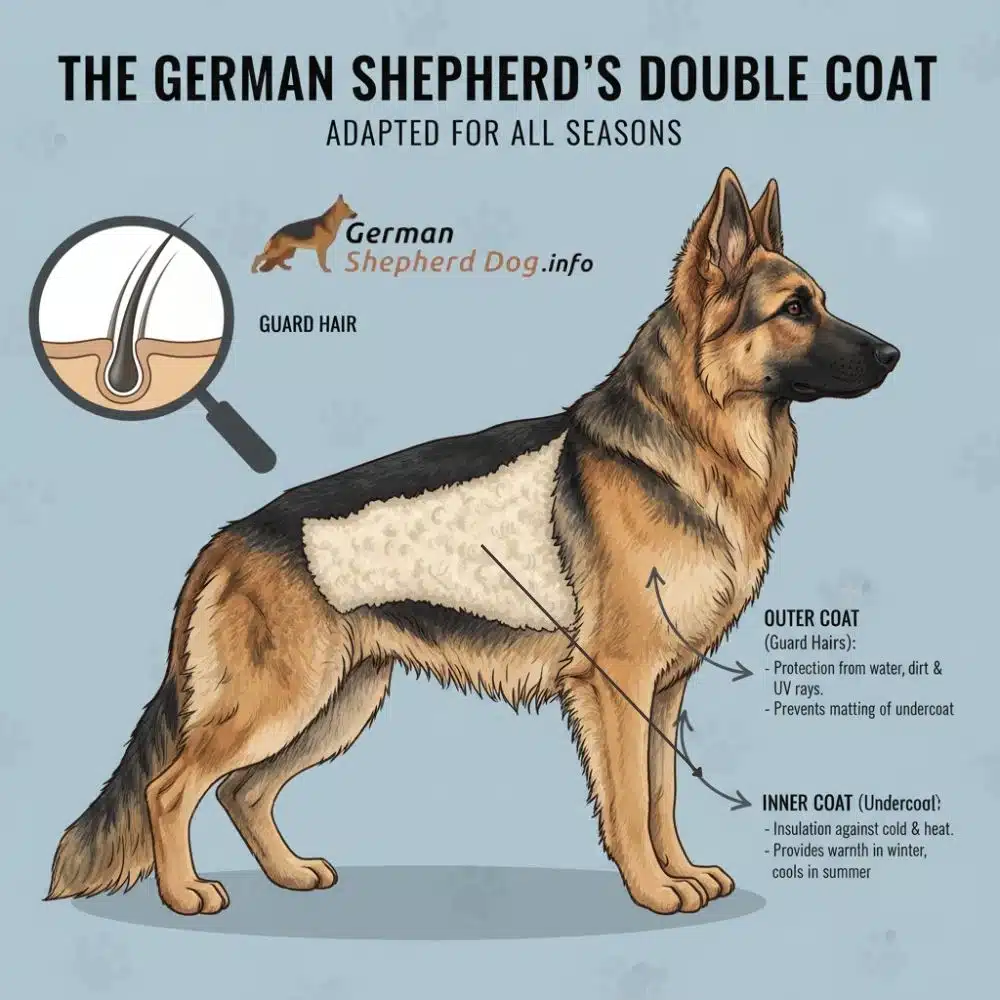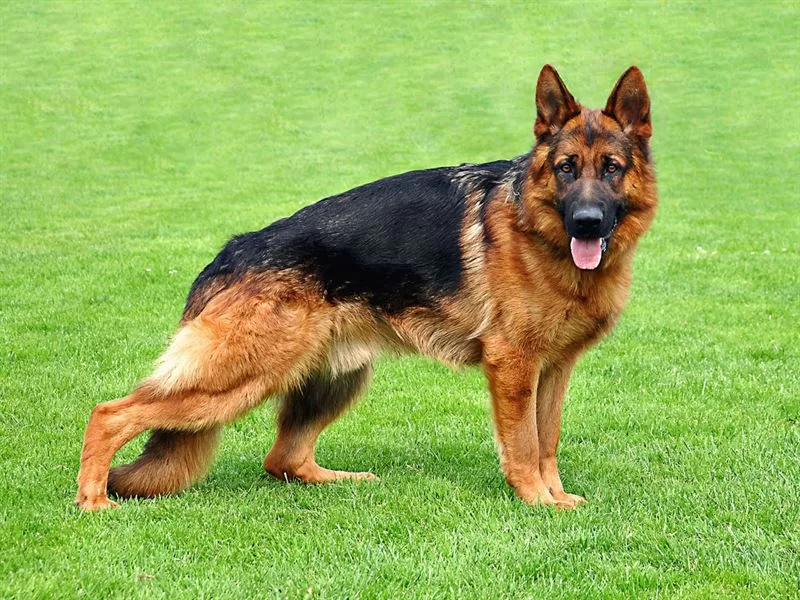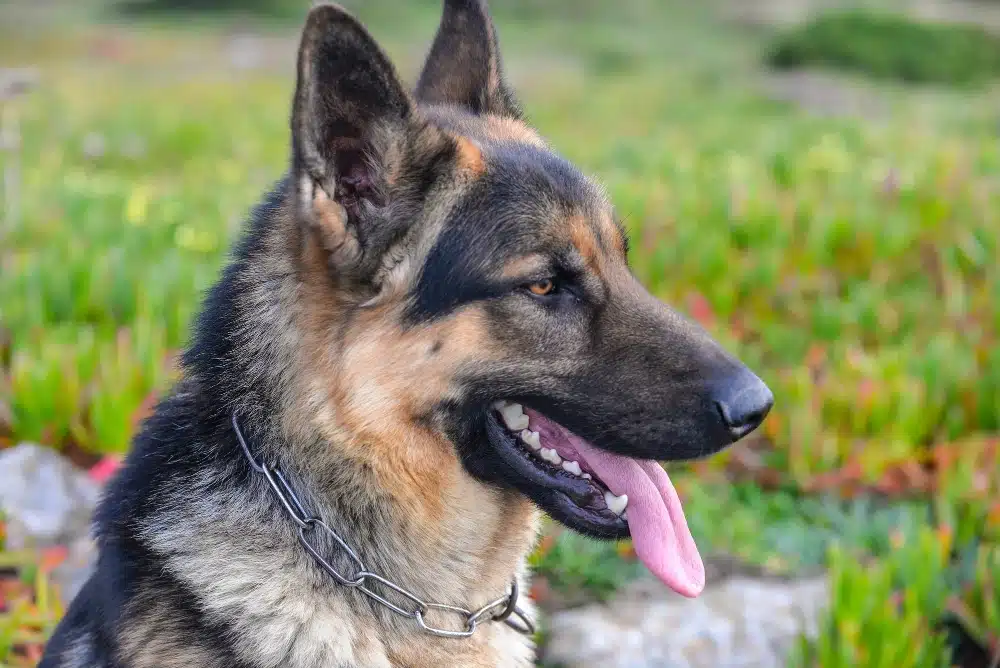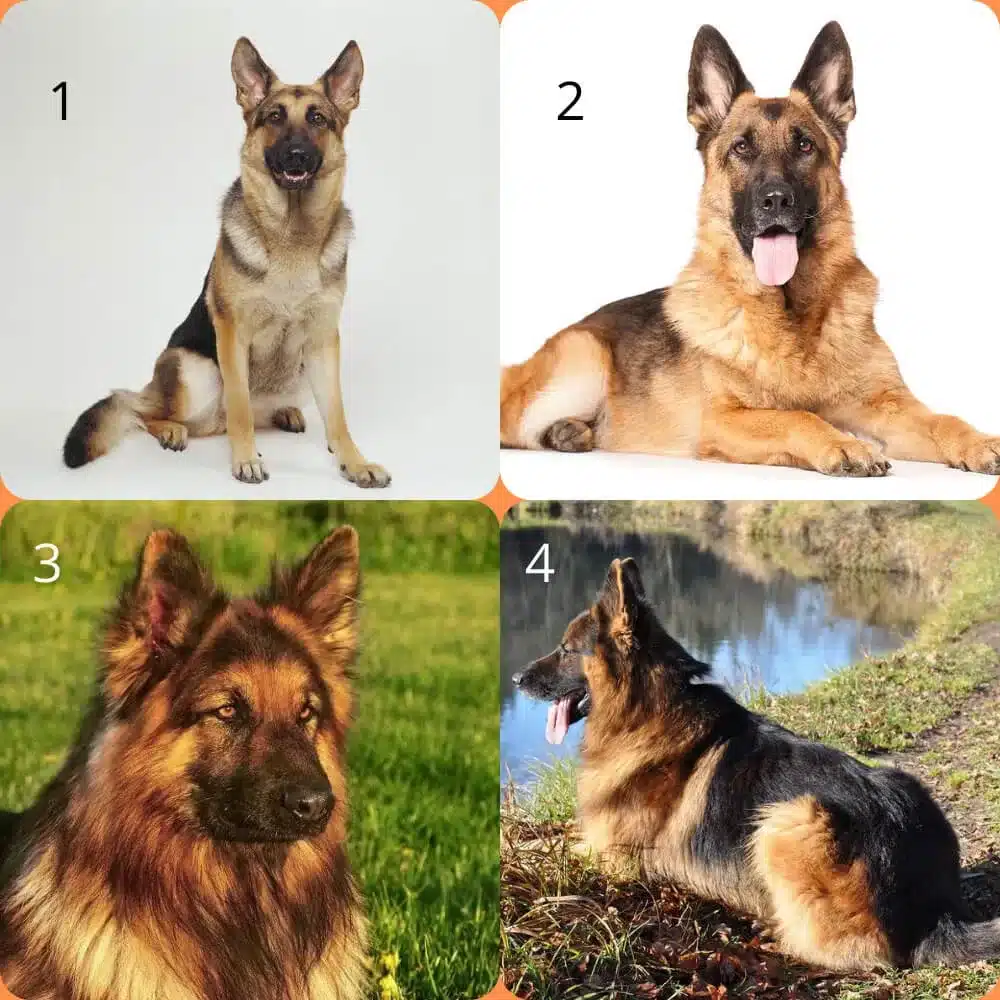When it comes to German shepherd single coat vs double coat, many pet owners actually get confused about what their dog is and how to properly care for it.
Table of Contents
As an experienced German Shepherd owner and trainer, I’ve noticed that despite their incredible popularity—ranking among the top 5 most popular breeds in the United States according to the American Kennel Club and with same popularity in India—there’s still widespread misunderstanding about their coat types.
Here’s a surprising fact: all German Shepherds have a double coat . While the appearance might vary, this natural double-layer coat system serves an important purpose.

The outer guard layer protects your GSD from environmental elements like rain and snow , while the undercoat provides insulation.
This double coat characteristic is directly tied to their historical roles and origins , providing both protection and comfort for these hardworking dogs. Whether you’re dealing with seasonal “blowing” of the coat that occurs primarily during transitional phases between seasons , or you’re trying to determine if your pup has what some mistakenly call a “single coat,” we’ll clear up the confusion in this article.
Understanding the German Shepherd Coat Structure
German Shepherds possess a fascinating coat structure that serves multiple purposes beyond mere esthetics. As I’ve observed through years of ownership, understanding the difference between coat types is essential for proper care.
Outer Guard Hairs vs Undercoat: What’s the Difference?
The German Shepherd’s double coat consists of two distinct layers that work together as a functional system. The outer guard hairs form a protective barrier made of longer, coarser strands that repel moisture and dirt. These stiff hairs shield your dog from environmental elements such as rain, snow, and UV rays.
Underneath lies the softer, denser undercoat that serves as insulation. This layer traps body heat during cold weather and helps regulate temperature in warmer conditions. The undercoat, often lighter in color than the outer coat, undergoes significant changes throughout the year, especially between seasons.
The difference between these layers is both structural and functional. The outer guard hairs have a slower growth rate and are more resilient, creating that distinctive German Shepherd appearance, furthermore protecting the softer undercoat from getting wet.
Why Most German Shepherds Are Double Coated by Nature
German Shepherds developed their double coat primarily as an adaptation to their original working environment. Since these dogs originated in Germany in the late 19th and early 20th centuries, they needed protection from varied climates. Their role as herding dogs exposed them to everything from snowy winters to warm summers.
This natural insulation system reflects their evolutionary history. The American Kennel Club confirms that the breed’s double coat consists of a “dense, harsh, and close-lying outer coat with a softer undercoat”. This combination enables German Shepherds to thrive in diverse environments without additional protection.
Essentially, the double coat is a signature trait of the breed that helped establish their reputation as versatile working dogs. Their ability to regulate body temperature regardless of external conditions made them ideal companions for shepherds working in changing weather.
Plush Coat German Shepherd: A Middle Ground?
Among the coat variations, the plush coat German Shepherd represents an interesting middle ground. This coat type falls between the standard stock coat and the longer coat varieties.
The plush coat is notably thicker and fuller than the standard stock coat but shorter than the long coat. Many consider it the most desirable coat for conformation events and dog shows. These dogs have long patches of soft fur around their ears and on the backs of their legs, with an overall coat length between 1-2 inches, compared to the short coat’s 1-inch length.
What makes plush coat GSDs interesting is that a recessive gene causes this coat length, making them somewhat rare. However, regardless of coat length, all properly bred German Shepherds maintain the double-coat structure with both protective outer layer and insulating undercoat.
The plush coat maintains all the functional benefits of the double coat system while adding a distinctive appearance that many owners find appealing.
How to Identify Your GSD’s Coat Type
Identifying your German Shepherd’s coat type requires a trained eye and attention to specific details. As I’ve handled many GSDs over the years, I’ve learned to quickly differentiate between coat variations through simple visual and tactile observations.
Visual Signs of a Double Coat

A double-coated German Shepherd displays several distinctive characteristics that make identification straightforward once you know what to look for. First, examine the neck and shoulder area where the fur typically appears thicker and forms a slight mane-like appearance.
Additionally, run your fingers through the coat—you should clearly feel two distinct layers. The outer guard hairs will feel coarser and stiffer, while beneath them, you’ll detect the softer, fluffier undercoat.
Double-coated GSDs also have visible “tufts” of fur, particularly behind the ears, between the toes, and on the back of the legs. Moreover, the fur around the neck and chest area tends to be notably thicker than on other parts of the body.
During seasonal changes, you’ll notice increased shedding as they “blow” their undercoat.
How to Spot a Single Coat GSD

Contrary to popular belief, truly single-coated German Shepherds are quite rare. What many owners mistake for a single coat is actually a double coat with a less prominent undercoat.
Nevertheless, GSDs with what appears to be a single coat have fur that lies flatter against the body and lacks the distinctive thickness seen in standard double coats.
When you run your hand through a seemingly single-coated GSD’s fur, you’ll notice less resistance and a more uniform feel throughout.
The hair appears more consistent in texture from root to tip. Consequently, these dogs shed more consistently year-round rather than having dramatic seasonal shedding periods.
Long Coat vs Double Coat vs Single Coat: Key Differences

The primary distinction between these coat types lies in their appearance and texture. Long-coated German Shepherds have visibly longer guard hairs, you can clearly see in the above image number 3 and 4, particularly around the ears, neck, legs, and tail, creating a distinctly fluffy appearance. Yet, most long-coated GSDs still possess a double-coat structure—the primary difference being the length of the outer guard hairs.
Above 1 and 2 are mostly considered as single coat German shepherd dogs.
Double coats feel denser and thicker when you run your hands against the grain of the fur. In contrast, what appears to be a single coat feels thinner and more uniform. Furthermore, double-coated GSDs typically have a more pronounced color variation between their topcoat and undercoat.
The easiest way to differentiate them is by examining the fur behind the ears and on the britches (back of thighs)—long-coated GSDs have distinctive feathering in these areas, while standard double coats show moderate thickness, and apparent single coats display minimal insulation.
Grooming Needs Based on Coat Type
Proper grooming routines differ significantly based on your German Shepherd’s coat type. As a long-time GSD owner, I’ve discovered that tailoring your approach is key to maintaining both your dog’s comfort and your sanity during shedding season.
Brushing Frequency: Single vs Double Coat
For double-coated German Shepherds, regular brushing is non-negotiable. The general rule is to brush at least 2-3 times weekly for normal maintenance. In contrast, dogs with what appears to be a single coat (though remember, most GSDs have some form of double coat) typically require less intensive brushing but may need more consistent attention year-round instead of dramatic seasonal care.
During shedding seasons (spring and fall), double-coated GSDs need daily brushing as they “blow” their undercoat. This intensive shedding period demands extra attention to prevent matting and excessive fur around your home.
Best Brushes for Double Coat German Shepherds
Your grooming toolkit should include multiple brush types for different purposes:
- Slicker Brush: Perfect for daily maintenance and removing surface tangles. Its fine, densely packed wire bristles help with the topcoat and lightly penetrate the undercoat.
- Undercoat Rake: Essential during shedding seasons. The long teeth reach through the topcoat to remove loose undercoat without damaging the protective outer layer.
- De-shedding Tool (like FURminator): Highly effective for removing deep, loose undercoat fur, but should be used sparingly to avoid thinning the topcoat.
- Wide-toothed Metal Comb: Ideal for finishing and detecting hidden mats, particularly under legs and behind ears.
Bathing and Drying Tips for Long-Haired GSDs
Long-haired German Shepherds don’t require frequent baths—every 2-3 months is typically sufficient. Bathing too often strips natural oils, potentially causing dry skin and coat issues. Before bathing, thoroughly brush to remove loose fur and tangles.
For drying, first press a towel against their coat to absorb moisture rather than rubbing, which can cause tangles. Subsequently, use a dog-safe dryer on a low, warm setting, blowing against hair growth direction to dry both layers.
Why Shaving a Double Coat is a Bad Idea
Regardless of temptation, never shave your double-coated German Shepherd. Unlike humans, their coat actually helps regulate temperature in both hot and cold weather. Shaving disrupts this natural insulation system and can lead to:
- Overheating: Without proper insulation, dogs lose their ability to regulate body temperature
- Sunburn: The outer coat protects skin from UV rays
- Permanent damage: The coat may grow back unevenly, with altered texture, or not at all
Many owners mistakenly believe shaving helps cool their dog in summer, yet it actually removes their natural cooling system.
Seasonal Shedding and Coat Maintenance
Living with a German Shepherd means accepting fur as a constant companion in your home. Unlike some breeds, GSDs have earned the nickname “German Shedders” for good reason!
When Do GSDs Blow Their Coat?
German Shepherds typically “blow” their undercoat twice yearly during spring and fall. This natural process allows them to adapt to changing seasons. As days shorten in autumn, GSDs shed their summer coat to grow a thicker winter coat.
Likewise, in spring, they shed their dense winter undercoat to prepare for warmer weather. Each blowing coat cycle can last approximately 10-20 days, creating what many owners describe as a “fur explosion” throughout the home.
The timing varies slightly depending on your climate zone and your dog’s individual genetics. Hence, you’ll need to watch for increased loose fur as seasons change rather than expecting shedding on specific calendar dates.
How to Manage Heavy Shedding Periods
Managing a GSD during shedding season requires preparation and consistency:
- Daily brushing becomes essential during heavy shedding periods. Use an undercoat rake or de-shedding tool to remove loose fur.
- Bathing strategy: Bathe your GSD before brushing, then while still sudsy, use a metal rake to remove excess undercoat. This technique keeps hair from flying everywhere.
- Outdoor grooming whenever possible—many experienced owners recommend brushing outside.
Between major shedding periods, maintaining a regular 3-4 times weekly brushing schedule helps control year-round shedding.
Diet and Supplements for Coat Health
Proper nutrition significantly impacts coat condition and shedding volume. A well-balanced diet rich in high-quality protein (25-30% for adult dogs) supports healthier fur. Foods containing Omega-3 and Omega-6 fatty acids are particularly beneficial for coat health.
Fish oil supplements containing DHA and EPA can markedly reduce excessive shedding by improving skin hydration and hair follicle strength. Beyond supplements, ensuring your GSD stays properly hydrated is fundamental for maintaining skin elasticity and coat quality.
For GSDs experiencing unusually heavy shedding outside normal seasonal changes, consider consulting your veterinarian—sometimes excessive fur loss indicates underlying health concerns requiring attention.
Common Owner Mistakes and Misconceptions
Many German Shepherd owners fall prey to common misconceptions about coat care that can affect their dog’s health and comfort. Throughout my years with these magnificent dogs, I’ve witnessed firsthand how these misunderstandings can lead to problems.
Thinking Single Coat Means Less Maintenance
One persistent myth is that GSDs with seemingly single coats require less grooming. In reality, all German Shepherds need regular maintenance regardless of coat appearance. Some owners incorrectly assume that dogs with less visible undercoat shed less or need less brushing. Unfortunately, skipping regular brushing leads to matting and excessive shedding throughout your home. Even GSDs with less prominent undercoats still need consistent grooming to maintain coat health.
Buying Based on Looks, Not Lifestyle Fit
Often, prospective owners choose a particular coat type purely for esthetics without considering maintenance requirements. Long-haired GSDs might look stunning, yet they typically need more attentive grooming to prevent tangles, primarily around ears and behind legs.
Short-haired GSDs, although seemingly lower-maintenance, still shed abundantly and require regular brushing. As a general rule, prioritize finding a dog whose activity level and temperament match your lifestyle first, considering coat type as a secondary factor.
Misunderstanding the Role of the Undercoat
Perhaps the most dangerous misconception involves shaving double-coated GSDs. Many owners incorrectly believe shaving helps cool their dog in summer. In fact, the undercoat acts as natural insulation, protecting against both heat and cold. Shaving permanently damages the coat’s structure and interferes with temperature regulation. Similarly, over-bathing strips essential natural oils, worsening shedding and causing dry skin. Using human shampoo can further damage your GSD’s coat, as these products aren’t formulated for canine skin pH levels.
Comparison Table
| Characteristic | Standard Double Coat | Apparent “Single” Coat | Long Coat |
| Coat Structure | Two distinct layers: coarse outer guard hairs and soft undercoat | Less prominent undercoat, more uniform feel | Longer guard hairs with double-coat structure |
| Thickness | Dense and thick | Thinner, lies flatter against body | Notably thick with distinctive feathering |
| Distinctive Features | Visible tufts behind ears, between toes, and on back of legs | More consistent texture from root to tip | Long fur around ears, neck, legs, and tail |
| Brushing Frequency | 2-3 times weekly (normal), daily during shedding seasons | More consistent year-round brushing | Not specifically mentioned |
| Seasonal Shedding | Heavy seasonal “blowing” of coat twice yearly | More consistent year-round shedding | Not specifically mentioned |
| Length | Around 1 inch | Not mentioned | Visibly longer than standard |
| Protection Features | Repels moisture and dirt, provides insulation | Less insulation than standard double coat | Maintains double-coat protection features |
| Common Areas of Thickness | Neck and shoulder area, forms slight mane | Less pronounced thickness | Behind ears and britches (back of thighs) |
Conclusion
Throughout my years as a German Shepherd owner, I’ve witnessed countless misconceptions about these magnificent dogs and their coats. Most importantly, all German Shepherds have a double coat, regardless of appearance. The varying thickness and length might create the illusion of a “single coat,” but this natural two-layer system serves crucial purposes – protecting against environmental elements while regulating body temperature.
Proper coat care remains essential for all GSDs, regardless of coat type. Regular brushing prevents matting and excessive shedding, with frequency increasing during seasonal “blowing” periods. Additionally, appropriate tools make a significant difference – slicker brushes for daily maintenance, undercoat rakes during shedding seasons, and occasional use of de-shedding tools for stubborn undercoat removal.
Many owners unfortunately make decisions based on appearances rather than understanding coat maintenance requirements. Consequently, they might choose long-haired varieties without recognizing the additional grooming needs, or worse, shave their double-coated companions thinking it helps with heat regulation.
Your German Shepherd’s nutrition also plays a vital role in coat health. Quality protein and omega fatty acids contribute to a healthier, more manageable coat, while proper hydration supports skin elasticity and overall coat condition.
As a fellow German Shepherd enthusiast rather than a veterinarian, my observations come from hands-on experience with these incredible dogs. Understanding your GSD’s specific coat type and needs will certainly lead to a healthier, happier companion. After all, those fur tumbleweeds rolling across your living room floor are simply part of the package when you welcome a German Shepherd into your life!
Key Takeaways
Understanding your German Shepherd’s coat type is crucial for proper care, health, and avoiding common grooming mistakes that could harm your dog.
- All German Shepherds have double coats with protective outer guard hairs and insulating undercoat, regardless of appearance variations.
- Never shave your GSD’s double coat – it disrupts natural temperature regulation and can cause overheating, sunburn, and permanent coat damage.
- Brush 2-3 times weekly normally, daily during spring/fall “blowing” seasons when they shed their undercoat for 10-20 days.
- Use proper tools: slicker brushes for maintenance, undercoat rakes for shedding seasons, and avoid over-bathing which strips natural oils.
- Quality nutrition with omega fatty acids and proper hydration significantly impacts coat health and reduces excessive shedding year-round.
The key to successful German Shepherd ownership lies in understanding that their double coat system is a functional feature, not just esthetic. Whether your GSD appears to have a single coat, standard double coat, or long coat, they all require consistent grooming and proper care to maintain their natural protective and insulating properties.
FAQs
What’s the difference between single and double coat German Shepherds?
All German Shepherds actually have a double coat, consisting of a protective outer layer and an insulating undercoat. What some people refer to as a “single coat” is typically just a less prominent undercoat, while a standard double coat has a more noticeable, thicker undercoat.
Q2. How often should I brush my German Shepherd?
For regular maintenance, brush your German Shepherd 2-3 times per week. During shedding seasons (spring and fall), daily brushing is recommended to manage the heavy shedding as they “blow” their undercoat.
Is it okay to shave my German Shepherd in summer?
No, shaving a German Shepherd is not recommended. Their double coat helps regulate body temperature in both hot and cold weather. Shaving can disrupt this natural insulation system and may lead to overheating, sunburn, and permanent coat damage.
What type of brush is best for a German Shepherd’s coat?
A combination of brushes works best: a slicker brush for daily maintenance, an undercoat rake for shedding seasons, and occasionally a de-shedding tool for stubborn undercoat removal. A wide-toothed metal comb is also useful for finishing and detecting hidden mats.
How can I reduce my German Shepherd’s shedding?
While shedding is natural for German Shepherds, you can minimize it by maintaining a regular brushing schedule, providing a balanced diet rich in high-quality protein and omega fatty acids, and ensuring proper hydration. Fish oil supplements can also help improve coat health and reduce excessive shedding.
